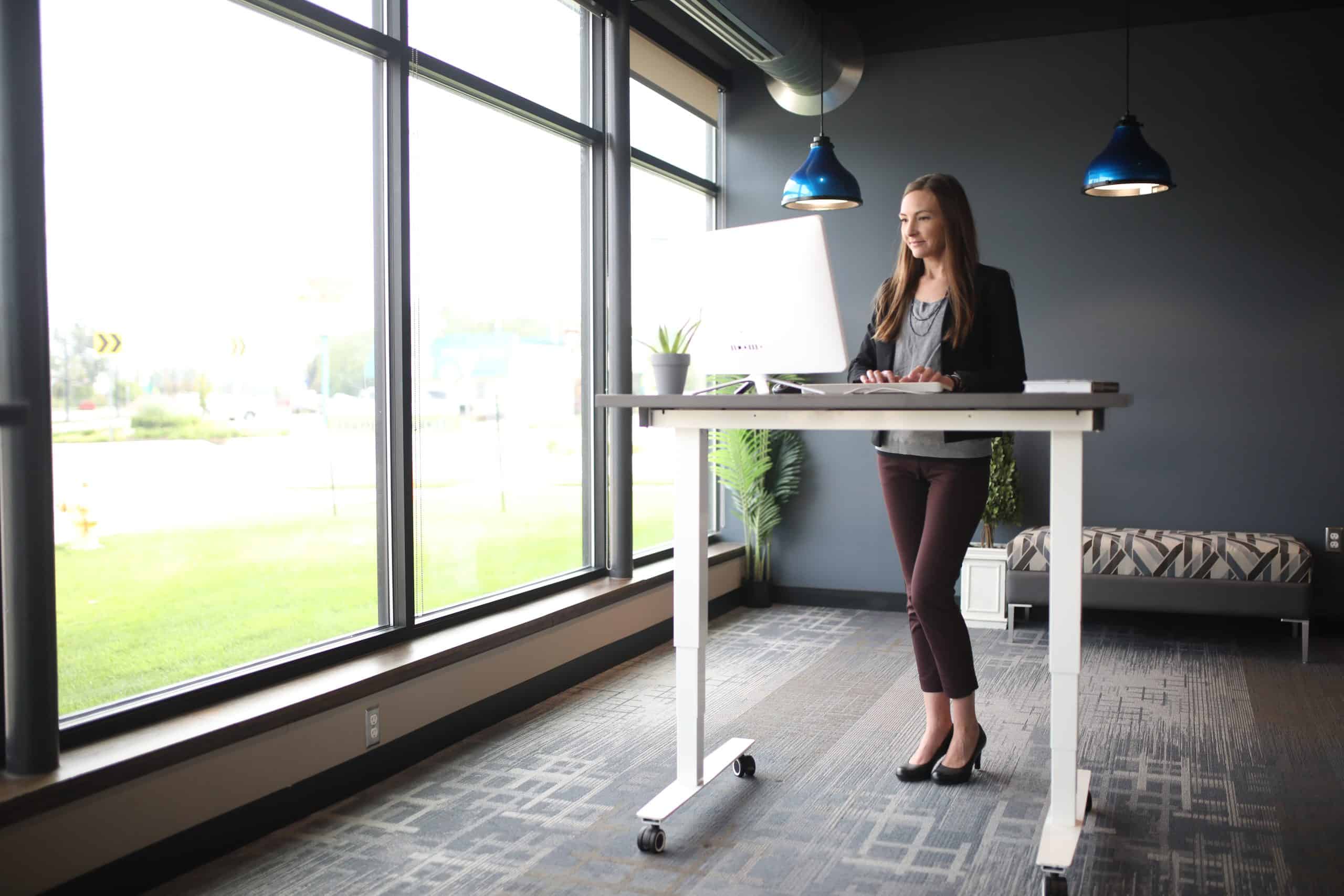We spend a considerable amount of time working, and all that time is usually spent sitting at a desk. Not that there’s anything wrong with sitting, but we sit for long hours during work, and we often forget to maintain good posture. Nobody’s blaming you; of course, it’s only natural to be focused on your work, but what about your health?
Prolonged sitting is never a good thing to put your body through. It prevents the blood from circulating freely in your body, and this may cause a slew of problems in the long run. A study even suggests that prolonged sitting can lead to hypertension and, believe it or not, exhaustion! You probably didn’t think that sitting would be able to exhaust you, but it actually can, both mentally and physically.
These are some of the reasons why standing desks are all the rage these days, and it’s important to learn how to use them correctly so that you can get the best use out of them. This is why in today’s post, we’ll explain how to stand at a standing desk correctly and share our tips on how to use a standing desk efficiently.
Let’s start by taking a look at some of the benefits of standing desks.

Are Standing Desks Good For You?
There are many reasons for the rising popularity of standing desks. They are versatile, they can boost your motivation, and most importantly, they are better for your overall health and posture.
Sitting for long periods causes the blood flow in your legs to decrease, and this may cause circulatory issues. You may not be familiar with what this may entail, but it’s actually more serious than it sounds. Bad circulation may cause cardiovascular diseases, which may even lead to an eventual heart attack. Research even states that people who sit over nine hours a day are more likely to die due to cardiovascular diseases.
Standing, on the other hand, eliminates all of these issues. Additionally, a standing desk can also improve your posture, as most of our posture problems stem from prolonged sitting in an incorrect position.
Moreover, standing is likely to aid you in losing weight if that’s what you’re after, since it requires most of the muscles in your body to be active, which should help you burn more calories.
Of course, all this goes without saying that none of this applies unless you follow a healthy diet and adopt an active lifestyle. A standing desk should not be considered an end-all-be-all solution to your weight-related health problems, but it certainly can help if you’re dedicated.
Lastly, another benefit of standing desks is that they can improve your motivation and overall performance at work. A new study has found that standing desks are not only beneficial for your cardiovascular health, but they are also beneficial for your work performance. Additionally, using a standing desk has proven to have a positive effect on human psychology, as staying physically active helps with mental health.
How to Use a Standing Desk
Now that we have cleared any doubts that might arise regarding standing desks’ effectiveness, let’s see what you can do to get the best out of your standing desk.
Pick The Right Desk
First things first, let’s start off by saying that not all standing desks are equal. Just like any other product, some models are simply better than others. Therefore, you should pick the one that fits your needs and preferences to get the most out of it.
A good standing desk should be height adjustable. Even though most standing desks on the market right now are height adjustable, their range may differ significantly. What you need to look for is a desk that can be raised all the way up to your ideal height, and then some more, just in case. We’ll explain how you can figure out your ideal sitting and standing desk height in a bit.
If the desk is used by more than one person, you should, of course, take the other person’s height into account as well. Keep in mind that the desk needs to go low enough so that you can also comfortably use it while sitting.
Another thing to look out for is the mechanism of a standing desk. Most modern standing desks nowadays are automatic and they require electricity to work. If you don’t want your desk to be hooked up to an outlet, you can opt for mechanical ones. These standing desks have a crank you can turn to raise or lower the desk.
Additionally, if you’re on a budget, you can consider other options, such as using a desk raiser. These are platforms that you place on your regular desk, and they are often height adjustable as well. A desk raiser can even feature an additional platform to place your monitor on so that you can adjust the monitor height independently.
If you want to learn more about the best DIY methods that will turn your desk into a standing one, you can check out our post on how to raise a desk.
Keep Good Posture
With the right standing desk at hand, what you need to learn now is how to stand correctly while working. Just like sitting, standing can also cause some posture problems and chronic pain. Therefore, it’s important to know the correct position you should be standing in.
Luckily, standing correctly isn’t nearly as hard as sitting in a correct position. When we sit down, our bodies relax involuntarily and we may end up in weird positions without realizing it. Standing up is another story as you don’t get the chance to relax too much, therefore, it’s more difficult to find yourself in a position that’s terrible for your body.
A good standing position is all about what height setting you’re keeping your desk at. Using your desk at a height that’s lower or higher than your ideal height can cause you to stand incorrectly without realizing it. To set your desk at the correct height, you can follow these simple steps:
- Stand in front of your desk with your shoulders back,
- Extend your arms with your elbows bent, but don’t force it,
- Adjust your distance to the keyboard so that your hands rest directly on the keyboard,
- Adjust the height of the desk until your elbows are bent at a right angle with your hands on the keyboard.
If you have posture-related issues and want to do more than just get a standing desk, we also recommend using posture correctors. Posture correctors are wearable contraptions that stretch your shoulders to prevent slouching. If you don’t know where to start, our buying guide on posture correctors can give you a general idea, and a few robust choices as well.
Set Your Monitor Correctly
You may not realize it, but the height of your monitor can really make a difference if you set it at the correct height. Adjusting the height of your monitor is key if you want to get the most out of your standing desk and stand correctly for optimal posture.
If your monitor is too low or too high, looking at your screen all day might put too much strain on your neck. This may cause a variety of problems, including chronic neck pain and bad posture.
Additionally, you should also consider the angle of your monitor, as setting it right can also improve your experience with your standing desk. Ideally, the monitor should be laid back by 10-30 degrees past the right angle. This will allow you to see everything on the screen simply by moving your eyes up and down instead of your head, which may cause neck stiffness and fatigue.
To set your monitor at the right height, you can follow these simple steps:
- Find your correct desk height first using the method we explained above,
- With your gaze parallel to the ground, look at your screen,
- Adjust the height of the monitor until your eyes meet the upper third of the screen.
If you don’t have a separate platform to adjust your monitor height, setting both your desk and monitor to the right height at the same time might not be possible. If this is the case, getting a monitor stand or an HUANUO Single Monitor Mount, 13 to 32 Inch Gas Spring... online, which are pretty affordable, can be an easy fix.
To learn more about the correct height setting for your monitor and how to set it right using a variety of methods, check out our post where we explained how high a monitor should be in detail.
Sit Down Every Once in a While
This may seem obvious, but having a standing desk doesn’t mean that you should be standing up all day. This is an unrealistic goal and not that great for your health. Much like sitting all day, standing for long periods frequently might also cause you some problems. This is why it’s important to know how to alternate between sitting and standing while you work.
Ideally, alternating every 30 to 60 minutes is what’s recommended. This should give your body a rest from standing while keeping your body active as you change positions. However, if you get tired easily, or if you prefer standing to sitting, you can go for 20 or 45-minute periods as well.
Keep in mind that it’s not recommended to stand for longer than two hours. A good rule of thumb to follow is to sit down for an hour for every hour you work standing up. This should help you keep a good balance.
To help you alternate between standing and sitting, you should use a good standing desk chair. If you don’t already have one, you can check out our buying guide where we reviewed six of our favorite standing desk chair options.
Consider Armrests
Last but not least, getting armrests for your standing desk can be a true game-changer. Just because you’re standing doesn’t mean that your body should bear all the weight. In fact, as opposed to standing freely, standing at a standing desk requires leaning. Over time, prolonged leaning may cause an imbalance in your spine, and this can hurt your posture.
Getting an armrest can be a great solution to combat this problem. You can easily find eulps Ergonomic Desk Extender, Computer Arm Rest for... online and they are usually pretty affordable. They are also very easy to install as you don’t need any tools. Look for one that has good padding, as some cheaply-made ones can hurt your forearms over time.
We also recommend getting Mount-It! Adjustable Arm Rest for Desk | Ergonomic... that you can attach separately to your desk for each arm. These are much more versatile as you can install both armrests to the exact positions you like.
Conclusion
As you see, there’s a lot that goes into using a standing desk properly, but one thing is certain: a standing desk has great benefits when it comes to our overall health. It can help prevent cardiovascular diseases and even improve our work efficiency.
To get the most out of your standing desk, you should consider the monitor and desk height, the model, and the features of the desk. Additionally, it’s always a good idea to take a break from standing. To keep a good balance, you can sit for an hour for every hour you work standing up.
Lastly, armrests can be a great addition to your standing desk as they provide extra support to your spine.
All in all, standing desks are a great option to try out if you have posture problems. Even if you don’t, using a standing desk can save you a lot of pain and discomfort in the long run. If you’re looking for a good standing desk with a wide height range, you can check out our buying guide for standing desks to find one you like.





